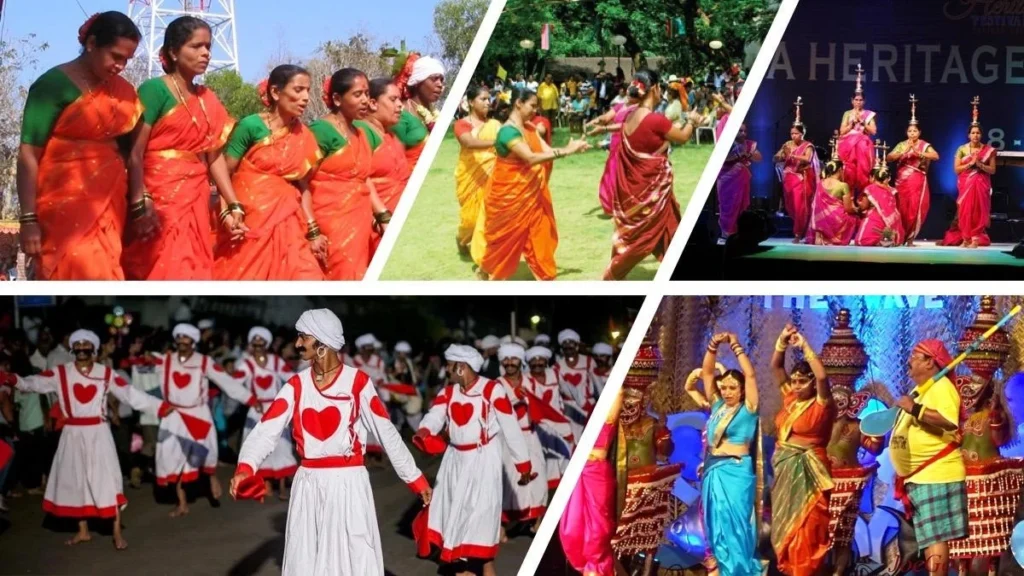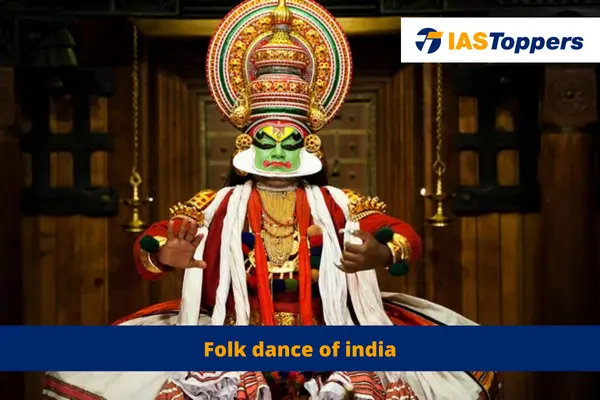Folk dances of India are celebrated worldwide, showcasing the joyful spirit of different occasions such as the start of a new season, the arrival of a baby, weddings, festivals, and gatherings. These dances are characterized by simple steps that are easy to learn and perform. In certain dances, men and women participate separately, while in others, they dance together, creating a harmonious display of unity. Singing and live music often accompany these vibrant performances. The dancers adorn themselves in exquisitely crafted costumes, enhancing the allure of their movements.
Folk dances of India will be helpful for UPSC IAS Exam preparation. GS Paper-1 Art and Culture.
Table of Content
- Folk Dances
- Features of Folk Dance
- Folk Dances of India State Wise
- Important Folk Dances of India
- Conclusion
- Frequently Asked Questions (FAQs)
Folk Dances
- Meaning: Folk dances are unique to each region, with various types practised across different areas.
- These dances are performed on numerous occasions, such as seasonal celebrations, childbirth, weddings, and numerous festivals.
- Folk dances are characterized by their simplicity, involving minimal steps or movements.
- Indian folk dances are known for their energetic and lively nature.
- Some dances are performed separately by men and women, while others involve both genders dancing together.
- Dancers often sing themselves during the performances, accompanied by musicians playing instruments.
- Each folk dance form has its own distinct costume and rhythm.
- The costumes worn for these dances are typically vibrant and adorned with elaborate jewellery and designs.

Features of Folk Dance
- Folk dances are a well-liked dance genre associated with specific people or regions.
- They serve as expressions of culture and often have ritualistic origins.
- Folk dances are passed down from one generation to another.
- They involve simple rhythms and follow specific movement patterns.
- These dances are performed to convey joy and happiness.
- Folk dances incorporate body movements, facial expressions, costumes, ornaments, and decorations.
Folk Dances of India State Wise
The important folk dances of different states are mentioned below:
| State | Folk Dances |
| Arunachal Pradesh | Bardo Chham |
| Assam | Bihu, Bagurumba, Bhortal, Jhumur, Khel, Gopal, Rakhal Lila, Tabal Chongli, Canoe, Nongkrem, Ankiya Nat, Kirtania Natak, Ojapali |
| Bihar | Jadur, Kathaputli, Bhako, Jhijiya, Karma, Jatra, Natna, Bidesia, Senkela Chhau, Jat-Jatni Bidpada, Ramkhelia |
| Chhattisgarh | Raut Nacha |
| Gujarat | Dandiya, Bhavai, Garba, Tippani Dance, Padhar dance, Dangi Nritya, Hudo, Matukdi, Aagwa, Siddi Dhamal |
| Haryana | Swang, Naqqal, Ras Leela, Dhamal dance, Manjira dance, Goga dance |
| Himachal Pradesh | Nati, Kariyala, Bhagat, Ras Ihanld, Harnatra Haran or Harin |
| Jammu and Kashmir | Bhand Pathar or Bhand lashna, Rouff, Vetal Dhamali |
| Karnataka | Yakshagana, Bedara Vesha, Dollu Kunitha, Santa, Doddata-Bayalata, Tala Maddle or Prasang, Dasarata, Radhna, Veeragase |
| Kerala | Duffmuttu, Oppana, Padayani, Theyam, Kodiyattam, Margam Kali, Puli Kali, Mudiattam, Thirayattam, Chavittu Nadakam, titambhu nritam, Chakyar koothu |
| Madhya Pradesh | Maanch, Nacha, Phul patti, Rai Tertali, Grida |
| Maharashtra | Tarfa Naach, Tamasha, Lalit Bharud, Gondha, Dashavatar, Lavani, Koli dance |
| Meghalaya | Shad sukmysiem, Shad nongkrem, Derogata, Do dru Sua, Laho |
| Nagaland | Chang Lo (Sua Lua) |
| Odisha | Pala Jatra, Daskathia, Mayurbhanj Chhau, Mangal Ras, Sowang, Sambalpuri (dalkhai, rasarkeli), parbha |
| Punjab | Naqqal, Swang, Bhangra |
| Rajasthan | Khyal, Rasdhari, Rammat, Turra Kilangi, Gauri, Ghoomar, Nautanki, Ihamtara, Kalbelia |
| Andhra Pradesh | Veethi Natakam, Burrakatha, Lambadi, Koya |
| Tamil Nadu | Therukuttu, Veethi Natakam, Bhagwat Mela Natakam, Kurvaanji, Pagal Vasham, Kavadi Chindu |
| Telangana | Bathukamma |
| Uttar Pradesh | Bhagat, Sang-Swang, Naqqual, Mayur Nritya, Charukala |
| Uttrakhand | Chholiya |
| Goa | Fugadi, Dashavatar, Perni jagar, Musal khel, Samai nrutya, Gonph dance, Dekhni, Kunbi dance, Ghode modni, Dhalo, Tonya mel, Talgadi |
| West Bengal | Chhau (Purulia), Santhali |
Important Folk Dances of India
The major folk dances of India are mentioned below:
| Folk Dances | State (Location) | Description |
| Chhau | Originates from Jharkhand, Odisha, and West Bengal | Chhau is a mask dance that vividly portrays mythological stories using energetic martial movements. It also incorporates natural themes such as serpent and peacock dances. Mayurbhanj Chhau artists do not wear masks. UNESCO recognized Chhau as an Intangible Cultural Heritage of Humanity in 2010. |
| Garba | Popular in Gujarat | Garba is a lively folk dance performed during the Navratri festival. Women dance in circular movements around a lit earthen pot called “Garbha deep,” accompanied by rhythmic clapping. |
| Dandiya Raas | Traditional dance form of Gujarat | Dandiya Raas is an energetic dance where performers use polished sticks called dandiyas. It represents a mock fight between the goddess Durga and the demon Mahishasura. |
| Ghoomar or Gangore | Performed by Bhil tribe women in Rajasthan | Ghoomar or Gangore is a traditional folk dance characterized by pirouetting movements. It highlights the vibrant colors of the flowing Ghaghra (long skirt). |
| Kalbelia | Performed by the Kalbelia Community of Rajasthan | Kalbelia is a sensuous folk dance resembling the movements of serpents. The dance is accompanied by the popular musical instrument “Been” played by snake charmers. UNESCO recognized Kalbelia folk songs and dances as Intangible Cultural Heritage of Humanity in 2010. |
| Charba | Traditional dance of Himachal Pradesh | Charba is a popular folk dance performed during the Dussehra festivities in Himachal Pradesh. |
| Bhangra/Giddha | Popular folk dance of Punjab | Bhangra is a highly energetic dance accompanied by infectious drum beats, while Giddha is the female counterpart of Bhangra. Both forms are prominent during festivities in Punjab. |
| Jawara | Harvest dance from the Bundelkhand region of Madhya Pradesh | Jawara is a harvest dance performed with a basket full of jawar (millet) balanced on the head. The dance is accompanied by heavy instrumental music. |
| Matki | Performed by women in the Malwa region | Matki is a solo dance form in which women balance multiple earthen pots on their heads. It is commonly performed during weddings and other festivities. Variants of Matki dance include Aada and Khada Nach. |
| Gaur Muria (Bison horn) | Ritualistic dance of the Muria tribes in Chhattisgarh | Gaur Muria imitates the movements of a bison and is performed by both men and women in group formations. The dance holds significance in the Bastar region. |
| Alkap | Rural dance-drama performance in Jharkhand and West Bengal | Alkap is performed by troops of dancers accompanied by lead singers known as gayens. The performance combines popular folk lore and mythological stories, including comical sketches called kap. It is associated with the Gajan festival of Shiva. |
| Paika | Martial folk dance of Southern Odisha | Paika is a dance form involving wooden spears and shields, showcasing the skills and agility of the dancers in infantry-like formations. It has martial arts characteristics and the word “Paika” signifies battle. |
| Jat-Jatin | Popular in the northern parts of Bihar | Jat-Jatin is a unique dance form representing the tender love and quarrels of a married couple. It is particularly prominent in the Mithila region. |
| Danda-Jatra | Oldest folk art of India, popular in Odisha | Danda Nata or Danda Jatra combines dance, drama, and music. While it mainly narrates stories about Shiva, the underlying theme revolves around social harmony and brotherhood. |
| Bihu | Popular dance of Assam | Bihu is a group dance performed by men and women. It involves colorful traditional dresses, group formations, rapid hand movements, and brisk footsteps. |
| Thang Ta | Exclusive martial dance form of Manipur | Thang Ta showcases skill, creativity, and agility through mock fight sequences with swords (Thang) and spears (Ta). |
| Rangma | War dance of the Nagas | Rangma involves colorful costumes, jewelry, and headgear. Dancers enact mock war formations and traditions. |
| Singhi Chham | Mask dance of Sikkim | Singhi Chham is performed by dancers dressed as snow lions, paying tribute to the Kanchenjunga Peak. |
| Kummi | Popular folk dance in Tamil Nadu and Kerala | Kummi is a circular dance performed by women, characterized by rhythmic clapping. It is traditionally performed during Pongal and other religious festivities. |
| Mayilattam | Peacock dance of Kerala and Tamil Nadu | Mayilattam involves young girls dressed as peacocks, complete with colorful headgears, beaks, and feathers. It is also known as the peacock dance and includes other similar dances like Kaalai Attam, Karadi Attam, Aali Attam, and Pampu Attam. |
| Butta Bommalu | Dance form from West Godavari district, Andhra Pradesh | Butta Bommalu showcases delicate movements and non-verbal music, with dancers wearing masks resembling toy-like characters. |
| Kaikottikali | Temple dance of Kerala | Kaikottikali is performed by both men and women during Onam to celebrate the rich harvest. Similar forms include Airukali and Tattamakali. |
| Padayani | Martial dance in Southern Kerala | Padayani is performed in Bhagavati temples, featuring dancers wearing large masks called kolams. The dance presents interpretations of divine and semi-divine narratives. Popular characters include Bhairavi, Kalan, Yakshi, and Pakshi. |
| Kolkali-Parichakali | Martial dance in Southern Kerala and Lakshadweep | Kolkali-Parichakali involves mock weapons made of wood, such as sticks (Kol) and shields (Paricha). The performance starts slowly but gradually builds up tempo, culminating in a frenzy. |
| Pata Kunitha | Dance form in the Mysore region | Pata Kunitha is a religious dance performed by men using long bamboo poles decorated with colorful ribbons. It is visually captivating and popular among people of all religions. Puja Kunitha is a variant popular in the Bengaluru and Mandya districts. |
| Chakyar Koothu | Art form of Kerala | Chakyar Koothu is a solo performance where the artist dresses as a snake. It combines prose and poetry, usually narrated in Malayalam. Traditionally performed by the Chakyar community, it features a colorful headgear, a large black mustache, and red spots on the body. |
| Jhoomar | Harvest dance performed by tribal Sikhs in Punjab | Jhoomar is a circular dance with arm movements accompanied by drum beats. The costumes are similar to Bhangra attire and were brought to India by traders from Balochistan. |
| Karma Naach | Tribal dance during the festival of “Karma” in Eastern India, especially Chota Nagpur Plateau | Karma Naach features dancers forming a circle with arms around each other’s waist. It is performed by various tribes during the festival of Karma. |
Conclusion
Folk dances hold a special place in the hearts of various cultures, serving as an essential link to their origins and nurturing a feeling of togetherness. These dances encapsulate the spirit of happiness, festivities, and cultural legacy, safeguarding the unique traditions and practices of specific areas for future generations to embrace and treasure.
Ref: Source-1
| Other Articles in History & Culture | |
| Indian Puppetry | Modern Indian Theatre |
| Kathakali | UNESCO World Heritage Sites |
| Folk Paintings of India | Kumbh Mela |
FAQs(Frequently Asked Questions)
Dandiya is a folk dance of which state?
Dandiya is a famous folk dance of the state of Gujarat.
Chhau is the folk dance of which state?
Chhau is originated mainly in Jharkhand, Odisha, and West Bengal.
Giddha is the folk dance of which state?
Giddha is a popular folk dance in the state of Punjab.
Lavani is the folk dance of which state?
Lavani is a famous folk dance of Maharashtra.
Bihu is the folk dance of which state?
Bihu is a folk dance in the State of Assam.


